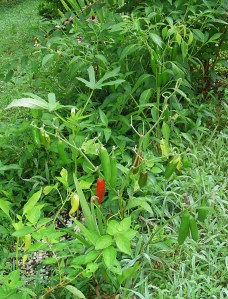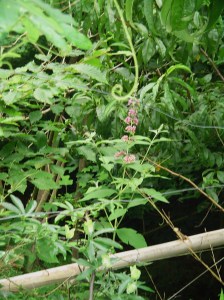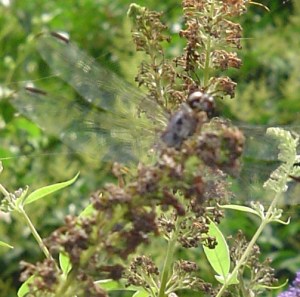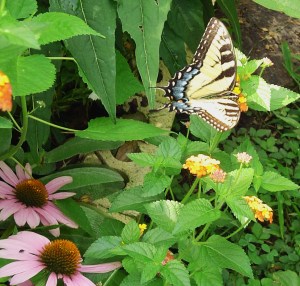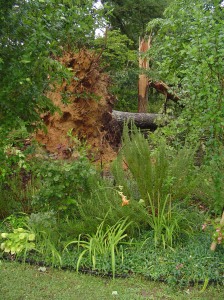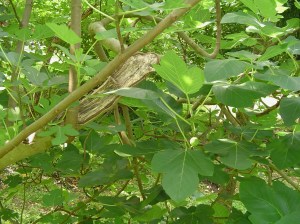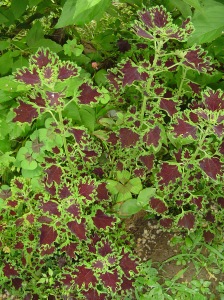
This Lady Fern has grown on the bank for years, never bothered by the deer. It is deciduous, but returns each spring larger than the year before.
The plants in the following list are mostly ignored by our herd of deer. They are well suited to our Williamsburg, Virginia Zone 7B climate and our soil. Some gardening friends and I have been compiling this list over the last few years.
We have observed that plants which grow extremely well in some of our gardens, such as Camellias and Hydrangea macrophylla, also called mophead Hydrangea; get eaten in others. Our mature Camellia shrubs are left alone, but I’ve had tremendous damage done to some, but not all, newly planted Camellias. Even newly planted oakleaf Hydrangeas have been stripped of their leaves during the last few weeks.
In fact, newly planted trees and shrubs are the most vulnerable because they are rich in the nitrogen based fertilizers growers lavish on them. They taste salty and delicious to deer, like salted French fries for us. Plants which have been in the garden a while tend to have less nitrogen in their leaves and so aren’t as tasty. When considering how much extra fertilizer to spread around your shrubs and trees, if any, this is an important consideration. Growing your garden on the lean side might offer additional protection from grazing.

Echinacea, or Purple Coneflower, is a favorite of nectar loving insects. A perennial, it is rarely touched by deer and grows more vigorous each year.
Key to symbols:
! a native plant in our area
# attracts birds with berries, fruit, nuts, or seeds
* a nectar producing plant which attracts butterflies and other pollinating insects
+ a nectar producing plant which attracts hummingbirds
Flowering Trees and Shrubs

Bamboo provides cover for nesting birds, shelter from the weather, and a steady supply of insects to eat. Deer never touch it.
# * + Althea, Rose of Sharon Hibiscus syriacus
! # Bayberry, or Wax Myrtle Myrica cerifera
! # * Beautyberry Bush Callicarpa americana
# * Boxwood Buxus sempervirens
! # * + Butterfly Bush Buddleia (various species)
# * + Butterfly Tree or Glory Tree Clerodendrum trichotomum
* Camellia C. japonica and C. sasanqua
# * +Crepe Myrtle Lagerstroemia
! # * Dogwood Cornus florida
# * English Laurel Prunus laurocerasus

Mountain Laurel blooms in early May in our neighborhood.
# Fig Ficus carica
* Forsythia
! # * Fringe Tree Chionanthus virginicus
! * Hydrangea arborescens
Japanese Maple Acer palmatum
* +Lilac Syringa vulgaris
# * Mahonia Mahonia aquifolium

“Josee” re-blooming Lilac, in its second flush of bloom in late June, is appreciated by all the nectar lovers in the garden.
! Mountain Laurel Kalmia latifolia (all parts of this plant are highly poisonous)
! # *Magnolia virginiana and other species

Fall blooming Camellia extends the months of bloom well into early winter. Deer don’t graze established shrubs.
# *Heavenly Bamboo Nandina domestica (all parts of this plant are highly poisonous)
! * Native Holly Ilex opaca
! # Oakleaf Hydrangea Hydrangea quercifolia
# * Fire Thorn Pyracantha (various species)
! # * +Red Bud Cercis canadensis
# * + Silk Tree or Mimosa Albizia julibrissin
# * St. John’s Wort Hypericum
! # Southern Wax Myrtle Myrica cerifera
! # + Red Buckeye Aesculus pavia
! #* Adam’s Needle Yucca filamentosa and other species
Perennials and Bulbs
Alocosia ( various species)
! # * + Butterfly Weed Asclepias species
* Caladium

Rose Mallow, Lavender, Artemesia and Dusty Miller hold no attraction for hungry deer.
* + Canna Lily Canna
* Centaurea ( various species)
! # * Coreopsis ( various species)
* + Crocosmia ( various species)
* Daffodil Narcissus ( various species)
! # * Daisy Asteraceae ( various species)
# * Dianthus ( various species)
! # * Purple Coneflower Echinacea purpurea
* Euphorbia ( various species)
# * Fall Anemones A. hupehensis
Fern (click for detailed information)

Autumn Brilliance fern produces coppery colored new leaves throughout the season. Here, trying to protect a little Hosta.
# * + Gaillardia ( various species)

The Passionflower vine can grow up to 50′ a year and produces edible fruit. Grown throughout warm climates, this perennial vine is beautiful and productive.
* Geranium ( various species)

St. John’s Wort
* + Ginger Lily Hedychium ( various species)
! * Goatsbeard Aruncus dioicus
* Goldenrod Solidago rugosa
* Lenten Rose Hellebore ( various species) (note, this plant is highly poisonous)
* Dutch Hyacinth Hyacinthus orientalis
* # Iris (Bearded, Dutch, Louisiana, Siberian, etc.)

Re-blooming Irises will bloom again in late summer, and then continue throwing out blooms through December. They need to grow in an area of full sun to continue blooming.
# Ivy
! # * + Rose Mallow Hibiscus moscheutos
! * +Joe Pye Weed Eutrochium ( various species)
# * Lambs Ears Stychys Byzantina
* + Mexican (Bush) Sage (Salvia leucantha) or Salvia Mexicana
* Muscari ( various species)
* Pelargonium ( various species)
* Peony Paeonia ( various species)
* + Red Hot Poker Kniphofia ( various species)
! # * Black Eyed Susans Rudbeckia ( various species)

Butterflies enjoy Echinacea growing here with Gaillardia, Comfrey, Pentas, and other herbs.

Gaillardia, gift from a friend’s garden, growing here with Comfrey.

Purple Ruffles Basil is one of he most beautiful.
Herbs
* Artemisia
# * Basil
* Comfrey
* Curry
# * Dill
* Fennel
* Germander
* + Lavender
* Mint

Pineapple Sage blooming in late October is a favorite food source for butterflies still in the garden

Pineapple Mint with Lavender
!# *+ Monarda
* Oregano
# * Parsley
* + Pineapple Sage Salvia elegans
* Rosemary
* Sage Salvia species
Annuals and Biennials
* Angelonia
Castor Bean (all parts of this plant are highly poisonous)

Ginger Lily, hardy in Zone 7
# *+Spider Flower Cleome hassleriana

Spider Flower, or Cleome, is beautiful in the garden and attracts butterflies and hummingbirds. Seen here with Lamb’s Ears and Coneflowers
* Dusty Miller Centaurea cineraria

Star Jasmine, also known as Confederate Jasmine, is evergreen, fragrant, and a magnet for butterflies. Very hardy, it grows enthusiastically.

Yucca filamentosa in bloom in partial shade.
# * + Foxglove Digitalis purpurea
# * + Lantana or Shrub Verbena Lantana camara
* + Mandevilla sanderi
* Mexican Heather Cuphea hyssopifolia
* New Guinea Impatiens Impatiens hawkeri
Persian Shield Strobilanthes dyerianus

Persian Shield
* + Pentas ( various species)
* Plectranthus ( various species)
* Purple Heart Tradescantia pallida
# * + Zinnia elegans
Vines
! * + Trumpet Creeper Campsis radicans
! * + Honeysuckle Lonicera sempervirens

Purple Heart, Sage, and purple Pentas are safe from deer grazing.
! # * + Passionflower Passiflora incarnata
* Periwinkle Vinca major & V. minor
# * Star Jasmine Trachelospermum jasminoides
! # * + Virginia Creeper Parthenocissus quinquefolia
Grasses
Bamboo (various species)
Miscanthus
Plants that will need extraordinary measures to protect in a forest garden include:
Azaleas, Hostas, daylilies, lilies, roses, impatiens, some Sedums, Tomatoes, squashes, sweet potato vines, cucumbers, beans, and mophead Hydrangeas.
All photos by Woodland Gnome.

Virginia Creeper is growing up this dead Black Locust tree, delighting all hummingbirds and butterflies in the garden with its huge orange blossoms.
- Still Optimistic…. (forestgardenblog.wordpress.com)
- A Beautiful Wildflower (forestgardenblog.wordpress.com)
- Bringing Birds To the Garden (forestgardenblog.wordpress.com)
- Figs (forestgardenblog.wordpress.com)
- Southern Wax Myrtle (forestgardenblog.wordpress.com)
- Camellias (forestgardenblog.wordpress.com)
- “Miss Huff” Perennial Lantana (forestgardenblog.wordpress.com)
- Information About the Beautiful Oakleaf Hydrangea (landscaping.answers.com)
- Goldenrod (forestgardenblog.wordpress.com)
- Pass Along Plants, Ginger Lily (forestgardenblog.wordpress.com)
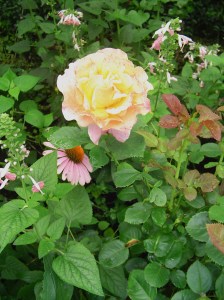 Every walk through the garden brings surprises.
Every walk through the garden brings surprises.
